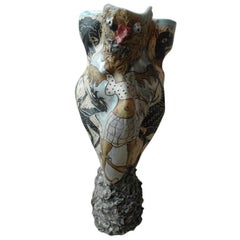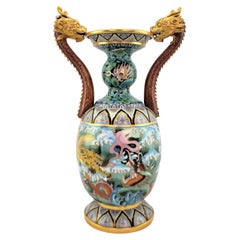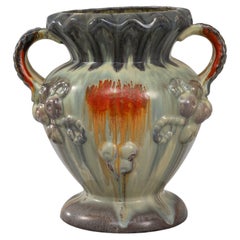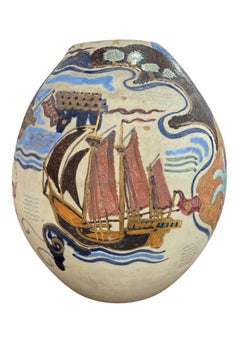Want more images or videos?
Request additional images or videos from the seller
1 of 18
Vase with Dragon headscirca 1885
circa 1885
$9,842.09
£7,316.91
€8,300
CA$13,639.37
A$15,205.27
CHF 7,930.18
MX$183,867.01
NOK 99,686.20
SEK 94,323.06
DKK 63,190.05
About the Item
Vase with Dragon heads
attributed to
Eugène ROUSSEAU (1827-1890)
and Ernest LEVEILLE (1841–1913)
A blown and crackled glass vase,
Decorated with polychrome stains in the glass
Flanked by gilded bronze Dragon heads
unsigned
Perfect condition
France
around 1885
height 23,5 cm
width 19 cm
depth 11 cm
Biography :
François-Eugène Rousseau (1827-1890), known as Eugène Rousseau, was a glassmaker who established himself in 1855 as a merchant specializing in porcelain and earthenware at 43 rue Coquillière in Paris. Around 1867, he turned to glassware and called on the talents of Eugène Michel to engrave a whole range of glassware in the “Art Nouveau” spirit. He took a particular interest in the innovative techniques of his contemporaries, and asked Marc-Louis Solon, then decorator at the Sèvres factory, to create works known as "pasta reports" (or paste-sur-pâte) which Solon signed under the pseudonym "Milès".
In 1867, while he was interested in Japanese motifs, Eugène Rousseau had Félix Bracquemond create a porcelain service intended to be presented at the Universal Exhibition in Paris, where for the first time a European artist directly copied a Japanese artist, reproducing animal figures from Hokusai's Manga. The two hundred pieces were made by the Lebeuf, Milliet et Cie Manufacture based in Creil and Montereau. Following the success of this service, Japanese aesthetics influenced Rousseau's production. In 1869, two of his painted glasses were purchased by the Victoria and Albert Museum. In 1884, he was the first to exhibit crackled glass at the Central Union of Decorative Arts, made using a 16th century Venetian technique. His Japanese-style glassworks, produced with the probable assistance of the Appert brothers in Clichy, appeared in 1874 in Paris at the 4th Exhibition of the Central Union of Fine Arts Applied to Industry. Rousseau was a member of the Central Union of Decorative Arts since its creation in 1862, and he received the cross of the Legion of Honor.
At the end of his career, he joined forces with Ernest Leveillé, who was also his student. Leveillé continued the work of Eugène Rousseau after his death, having purchased the funds from his workshop on rue Coquillière in 1885.
Ernest-Baptiste Léveillé (1841-1913), said Ernest Léveillé is a dealer and editor of bone China and crystals. He founded his company Léveillé in 1869 located at 74 Boulevard Haussmann in Paris, and then acquired in 1885 the house Eugène Rousseau, porcelain and crystal dealer and editor. He operated the contents of the Rousseau's studio from 1886 until 1890 under the name "Maison Rousseau et Léveillé réunies".
Léveillé created models and executed them according to very precise instructions. His cracked and engraved vases on three layers of glass earned him a gold medal. Renamed "E. Léveillé" after the death of Eugène Rousseau in 1890, the store was transferred in 1899 to 140 Faubourg Saint-Honoré in Paris. In 1902, Ernest Léveillé joined the company Toy specialized porcelain and crystal wares, under the name "Maisons Toy et Leveillé réunies". The property was then located at 10 rue de la Paix.
- Attributed to:Eugène ROUSSEAU (1827-1890) (1827 - 1890, French)
- Creation Year:circa 1885
- Dimensions:Height: 9.26 in (23.5 cm)Width: 7.49 in (19 cm)Depth: 4.34 in (11 cm)
- Medium:
- Movement & Style:
- Period:
- Condition:
- Gallery Location:PARIS, FR
- Reference Number:Seller: N.X1stDibs: LU2514216619152
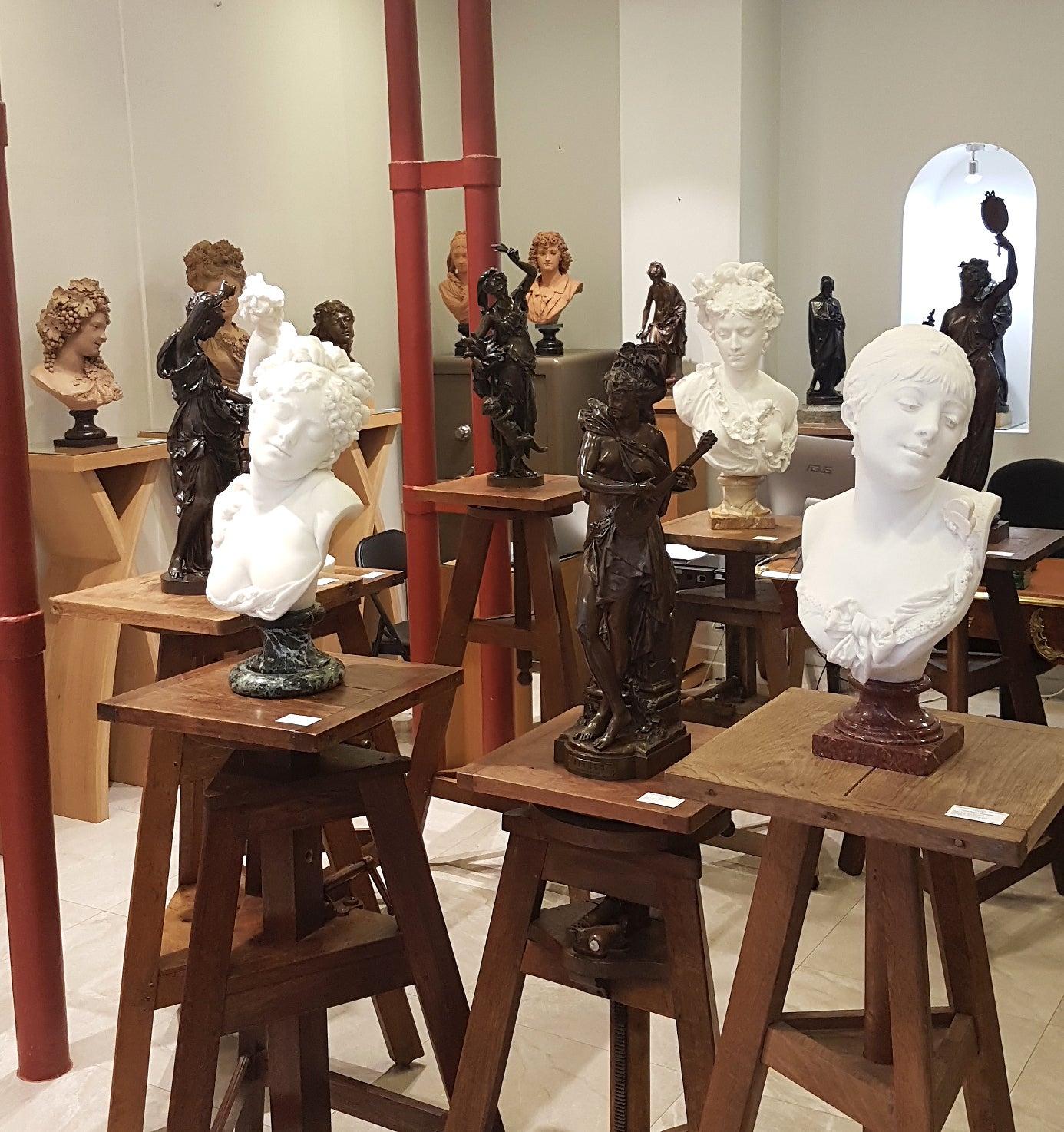
About the Seller
5.0
Recognized Seller
These prestigious sellers are industry leaders and represent the highest echelon for item quality and design.
Established in 1992
1stDibs seller since 2023
8 sales on 1stDibs
Typical response time: 1 to 2 days
- ShippingRetrieving quote...Shipping from: PARIS, France
- Return Policy
Authenticity Guarantee
In the unlikely event there’s an issue with an item’s authenticity, contact us within 1 year for a full refund. DetailsMoney-Back Guarantee
If your item is not as described, is damaged in transit, or does not arrive, contact us within 7 days for a full refund. Details24-Hour Cancellation
You have a 24-hour grace period in which to reconsider your purchase, with no questions asked.Vetted Professional Sellers
Our world-class sellers must adhere to strict standards for service and quality, maintaining the integrity of our listings.Price-Match Guarantee
If you find that a seller listed the same item for a lower price elsewhere, we’ll match it.Trusted Global Delivery
Our best-in-class carrier network provides specialized shipping options worldwide, including custom delivery.More From This Seller
View AllVase with Elephant heads
Located in PARIS, FR
Vase with Elephant heads
attributed to
Eugène ROUSSEAU (1827-1890)
and Ernest LEVEILLE (1841–1913)
A blown glass vase,
decorated in relief with stylized swirls
Decorated with polyc...
Category
Late 19th Century French School More Art
Materials
Blown Glass
Vase Cristallerie "rocaille"
By Émile Gallé
Located in PARIS, FR
Vase Cristallerie "rocaille"
by Emile GALLE (1846-1904)
Vase called "Cristallerie de Gallé".
A small vase with a swollen body and a narrow neck, resting on a foot.
Smoked glass, and...
Category
Late 19th Century French School More Art
Materials
Glass
Vase known as " Beijing Glass "
By Émile Gallé
Located in PARIS, FR
Vase known as " Beijing Glass "
by Emile GALLE (1846-1904)
Double layer glass vase
with red Lotus decor on white background.
Japanese style signature " Gallé "
Perfect condition
...
Category
Early 20th Century French School More Art
Materials
Glass
Vase "Erable plane"
By Émile Gallé
Located in PARIS, FR
"Norway maple" Vase
by Émile GALLE (1846-1904)
Rare baluster-shaped vase,
multi-layered glass with powder and gold foil inclusions.
Wheel-carved cameo decoration,
ornated with mapl...
Category
Early 1900s Art Nouveau More Art
Materials
Blown Glass
Vase with Carp
Located in PARIS, FR
Vase with Carp
by Eugène ROUSSEAU (1827-1890)
and Ernest LEVEILLE (1841–1913)
Sublime blown glass vase,
decorated in relief with a carp springing from the water.
Decorated with pol...
Category
1880s Art Nouveau More Art
Materials
Glass
Flowery Cristallerie Vase
By Émile Gallé
Located in PARIS, FR
Flowery Cristallerie Vase
by Emile GALLE (1846-1904)
Vase called "Cristallerie de Gallé"
Vase with rounded body and flaring neck,
ornated with stylized flowers and foliage.
Smoked ...
Category
Late 19th Century Art Nouveau More Art
Materials
Glass
You May Also Like
Surreal Vase
Located in NYC, NY
A surreal vase that has a different look from each side and is reminiscent of Picasso ceramics.
Category
21st Century and Contemporary American Vases
Materials
Pottery
$2,500
Large Vintage Decorative Chinese Cloissone Vase with Imperial Dragon Handles
Located in Hamilton, Ontario
This large vintage cloissone vase is signed by an unknown maker, and originated from China dating to approximately 1980 and done in a Chinese Export st...
Category
Late 20th Century Chinese Chinese Export Metalwork
Materials
Brass
20th Century Belgian Ceramic Vase
Located in High Point, NC
This 20th-century Belgian ceramic vase exudes elegance and charm with its ornate craftsmanship. Featuring a flared, scalloped rim and dual handles adorned with intricate braided deta...
Category
20th Century Belgian Vases
Materials
Ceramic
Grand vase de la Faïencerie Henriot Quimper
Located in PARIS, FR
Sublime vase by Jos Kervella is a French ceramist from Saint-Urbain, near Daoulas (Finistère). Gifted for the arts from childhood, he studied at the Lycée de Brest, where his talents...
Category
20th Century More Art
Materials
Ceramic
Meji Bronze Amphora, Japan, 1868-1912
Located in Roma, IT
This Meji bronze amphora is a superb bronze vase decorated with the depiction of flowers and frogs and on the sides a phoenix. A Japanese vase of the Me...
Category
Antique Late 19th Century Japanese Modern Vases
Materials
Bronze
Vase 1
By Ray Smith
Located in Cuernavaca, Morelos
Vase
Ceramics
Category
2010s Sculptures
Materials
Ceramic
$15,000
More Ways To Browse
Bronze 19 Century Chinese Vases
Cracked Glass Vase
Brown Dragon Vase
Sevres Crystal
Antique Saint Louis Crystal
Antique Bronze Dragon
Antique Dragon Head
Art Nouveau Glass Bronze Vase
Cracked Vase
1890 Stained Glass
John Isiah Walton
John Martin Hiss
John Osler
John S Shiach
John Stephen Dews
John Tarahteeff
Josef Thoma
Joseph Felix Bouchor
